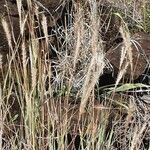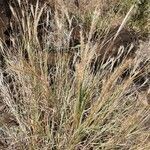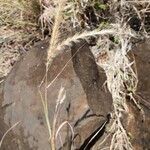Densely tufted perennial, 0.6-1.2 m high, reddish; culms branched, sometimes glaucous, tinged with purple or dark red. Leaf blade 100-300 x 2 mm; ligule a fimbriate membrane. Inflorescence digitate, of 2(-5) racemes; pedicels and internodes clavate, margins long-hairy; spikelets paired: one sessile, the other pedicelled. Sessile spikelet 5-7 mm long; glumes acute, awnless; lower glume deeply and very narrowly grooved, keels nearly meeting or narrow towards apex; upper glume convex on back. Florets 2; lower floret reduced to a lemma, awnless; upper floret bisexual, lemma lobed to middle, awn 25-30 mm long, twice geniculate, column twisted, short-hairy; callus obtuse. Pedicellate spikelet 5-10 mm long, longer than sessile spikelet, acute rarely acuminate, awnless, rarely mucronate. Flowering time Dec.-Apr.
Perennial; up to 1.2 m high; densely tufted; reddish; basal parts and rhizomes straight; basal sheaths hairy at base. Leaf blades 90-600 x 3-14 mm. Flowers: inflorescence digitate with 2(-5) spike-like racemes; sessile spikelets 5-7 mm long; pedicellate spikelets slightly longer; pedicels clavate; lower glume of sessile spikelets deeply and very narrowly grooved; keels nearly meeting; glumes not awned; lemma awn 25-30 mm long.
Sessile spikelet 4.3–8.5 mm long, strongly compressed between internode and pedicel, the conical callus deeply inserted in the internode apex; inferior glume with a ± deep median groove, glabrous; superior glume convex on the back, awnless; superior lemma bifid to the middle; awn bigeniculate, 22–40 mm long; anthers 2.5–4.5 mm long (longer in the pedicelled spikelet), straw-coloured or dark red.
Perennial, densely tufted, up to 1.2 m high, reddish. Leaf blades 90-600 mm long, 3-14 mm wide. Spikelets (sessile) 5-7 mm long (pedicellate slightly longer). Racemes 2(-5), pedicels clavate; lower glume of sessile spikelets deeply and very narrowly grooved, glumes unawned; lemma awn 25-30 mm long.
Racemes in terminal pairs, rarely in threes, 5–20 cm long, clearly exserted from the spatheoles, dark red, the pedicelled spikelets clearly imbricate on one side; peduncles much longer than the racemes; internodes and pedicels clavate, ciliate on both margins, the internodes bilobed at the apex.
Leaves glabrous, occasionally densely long-pilose; ligule a minute (0.5–1 mm) fimbriate membrane; laminas 10–26(30) cm × 2–(12) mm, flat, tapering at the apex, sometimes abruptly so, to a very fine point.
Pedicelled spikelet male, 6–11 mm long, clearly longer than the sessile, papery, purplish to dark red, awnless or occasionally mucronate.
Densely caespitose perennial; culms up to 200 cm high, erect, branched, sometimes glaucous, tinged with purple or dark red.



